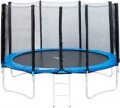Trampoline size (LxWxH)
The overall size of the trampoline; in this case, the height can be measured both by the height of the working surface, without taking into account the protective grid and other additional devices, and by the overall dimensions of the product in the working position. Also note that the size of the working area on the canvas is usually less than the overall dimensions in length and width — there is protection along the edges that covers the springs, and it is undesirable to jump on it.
Mesh height
The height of the regular trampoline protective net (see "Complete set"). This height is usually measured from the working surface, which allows you to evaluate the protective properties of the mesh. The higher it is, the better, but in general it is desirable that the height is not lower than the height of the intended user (or at least slightly lower).
Number of springs
The number of springs provided in the design of the trampoline of the corresponding type (see above).
The smaller the springs, the larger and thicker each of them must be in order to normally carry their “portion” of the load. However manufacturers usually choose the thickness and quantity in such a way as to achieve the required performance. Therefore, from the user's point of view, there is no key difference between an abundance of small springs and a few large ones, and this parameter, in fact, is purely reference.

